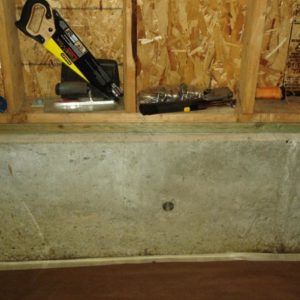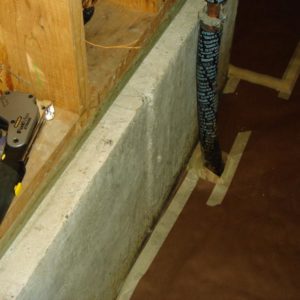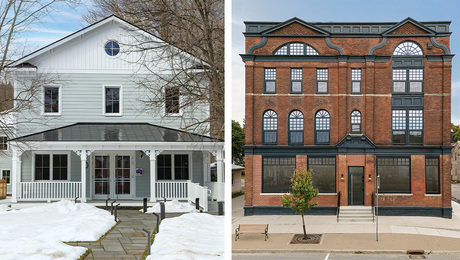foil faced or not??????
I’m sure the info I need is in some post, but the more I look the more confused I become =), so I’ll just ask:
I am framing the walls in my basement, and need to know what type of insulation to use on the concrete foundation walls. This is all a new experience for me and I want to do things right. From what I have read I adhere rigid insulation to the slab from the floor up to the bottom plate, then build a wall in front of that with pressure treated wood(want to keep as much space as possible so was going to use 2×2 instead of 2×4 to do this). Some things say I should use foil backed foam and some say no, which is it?? Also, once that little wall is built in front of the rigid, do I need to fill that space (between the drywall and rigid) as well with insulation, or can I leave it open (would make it easy to put all my electrical =)).
I’ve attached some pics, but basically it’s about a 18″ concrete foundation wall, with the standard wood framing on top of that for the basement walls. The floor was an old slab which I placed 6 mil vapor barrier, then 3inch pink rigid insulation, the wire mesh then added radiant tubing to that, and poured my new concrete floor on that (I put the rigid up the sides to meet with the new floor). The concrete has been polished and colored and will be the finished floor (that’s why in the pics it’s covered with paper).
As the framing wall will not be furred out, I know the part of the wall covering the foundation will come out about 5-6 inches . . . I just planned on placing beadboard over the drywall and a wood sill on top to create a “ledge” along these walls for placing things.
Any advice??
Thanks!!!





















Replies
OK, first the dial-uppers are going to keeeel you for attaching pics with files that big. A better size is around 400-500 KB.
Next- last time I did a basement, I glued 2" non-foil face rigid foam to the walls, taped the seams, and built my stud wall in front. IMO, you don't need any insulation between the studs. Since a basement is below grade, there's really not the temp swings you get like you do in the rest of the house. And I think its better to not have the foil. Regular foam will allow a little transfer of moisture, so you do't have it building up.
The PT studs will work fine, altho 2x2s are noted for readily twisting out of shape. I'd suggest either 2x3s, or using 2x4s on flat, or my preferred material for basement walls- metal studs. They're light, so they're easy to get into the basement; they're stable; they won't support mold growth. I'd suggest 2x3 steel for the perimeter walls, and 2x4 steel for any partitions.
Why not just skip the framing all together and use Dow Wall Mate.
I had just looked that stuff up on the internet. You would still have to frame, just into the stuff not in front of, right? I wonder how pricey the stuff is compared to the regular rigid? I live in Seattle, know of anyone who sells it?
Yeah, sorry for the pic sizes, didn't catch that in time (call me a newbie =)). Great point about the 2x2'S, hadn't thought about that! I like the idea of the metal studs, to be honest I've never heard of them. I have easy access into the basement through the garage doors and back french doors, so that's not an issue. Where would I find these and how do they compare in price to the pt's? Thanks!!! On more question, I don't need tar paper between the concrete and rigid insulation right? The insulation goes directly onto the concrete, then the wall goes in front of that. Thanks Again!!
First of all you only need PT for the footers on the concrete floor.If you need PT stud you have no business finishing the flooded basement.You can get metal studs at the home horror stores. They are usually limited to "2x4".But they are also available in 2 1/2" and 1 5/8" with matching track. I used the 1 5/8" stuff for the same project.You need to go to a DW supply company.When I did this Dietrich (sp?) metals had a bunch of instructions online showing how to use it for framing..
William the Geezer, the sequel to Billy the Kid - Shoe
Point taken on the PT stuff, and no there should be no flooding basement as I put the whole drainage system around the house =). Thanks for the tip on the Dietrich info, I will try to hunt for that!
No tar paper before the insulation. Just glue the foam right to the walls. But make sure you get a construction adhesive meant for foamboard, or it'll melt your foam instead of glueing it.
I'm not sure about the price of metal studs at the moment. There's been times they've been cheaper than wood, and times they're more expensive. I have no idea why. But they do go up quite quickly. Pluys there's knockouts already in the studs for running wires and pipes, so you don't need to drill.
Like someone else said, the big boxes will have 2x4 metal studs and track. But if you can find a good lumber yard or sheetrock supplier, you can get 2x2 or 2x3 studs and track.
Fine Homebuilding had a very good article on finishing basements a few years ago. It was written by Andy Engel. You might want to check that out.
Thanks so much for all the info!
Use non-foil faced foam and tape the seams. The foam needs to be semi-permeable to vapor so the walls can dry to the inside. Foil won't let this happen.
I suggest using 1 5/8" metal studs, 20 gauge. They'll be dead straight, save space, and never rot. Put some dense XPS foam between the bottom plate and the slab -- it will prevent rust and provide a thermal break. 1/2" to 1" of foam is fine. There's a learning curve to using steel over using wood.
See photos below.
Billy
Wow, what beautiful pictures!!!!! Thanks for the advise also =). I did purchase the 1 5/8 metal, though I they gave me 25ga instead of 20. This wall will only be about 32-36 inches tall, just enough to cover the concrete wall and will leave about a 6-7" finished ledge when it's all done. For taping/sealing the foam together, when it's up tight against each other I'll tape, but the wall I started on has a sloped floor (garage) so where the foam isn't butted tight I just sprayed that expandable foam to fill up the cracks. Seems to work ok. Just getting started with it all so we'll see how it goes! By the way what's the best way to cut that metal . . . I'm assuming just use a saw with an appropriate metal blade? Oh, and I did buy some 1" rigid to go under the metal track. Thanks!!Janette
For 25 ga use metal snips. If you really want a new tool, Harbor Freight sells metal cutoff saws that use an abrasive wheel, but the snips should work fine. Wear gloves, don't cut yourself on the sharp metal, and clamp the stud to the track when you drive in the screws.
Using the expandable foam to fill cracks is perfect.
Billy
Awesome, thanks so much!!!